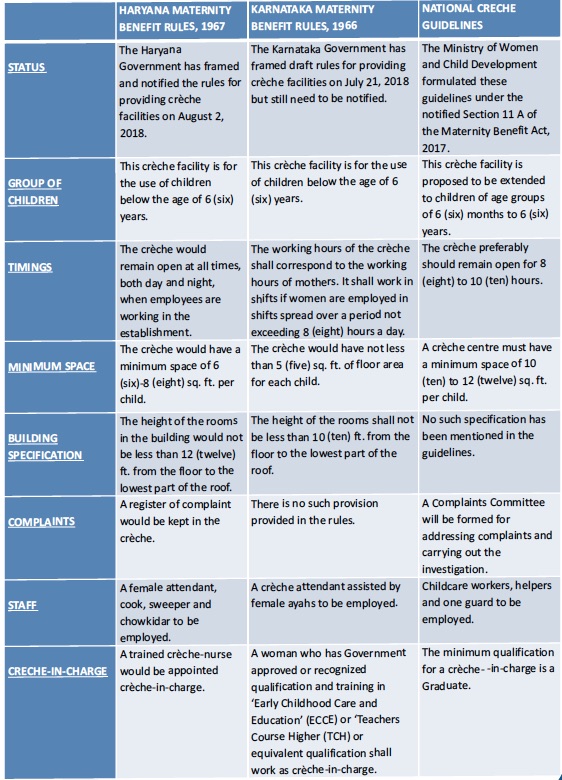17 January, 2019
The Indian working parents have a lot to cheer about with respect to the national crèche guidelines, although the same might not be true for Indian employers. The Crèche Guidelines are a relief for they do answer some open issues, however, they also raise additional ambiguities and pose added compliance burden for the employers.
In terms of the Maternity Benefit Act, 1961 (the “MB Act”), as amended by the Maternity Benefit (Amendment) Act, 2017 (the “Amendment Act”), a new provision was introduced which requires establishments having 50, or more employees to have a crèche facility within the prescribed distance, either separately or along with other common facilities.
The Amendment Act however did not provide any clarity on aspects pertaining to the crèche facility, more significantly, about how the crèche facilities need to be provided and who bears the cost burden. In the absence of any comprehensive rules or guidelines for the implementation of the crèche facility provision, the Ministry of Labour and Employment vide its notification dated 17th November 2017, required the State Governments to frame rules regarding the facilities to be provided in the said crèches.
Overall, the State Governments (barring a few) failed to rise to the challenge and issue any rules or guidelines governing crèche facilities. Up till now the employers were drawing guidance from other employment and social welfare legislations which have provisions dealing with crèche facility. The Ministry of Women and Child Development, Government of India, recognized the need to prescribe a list of minimum standards and norms to standardize the quality of crèche facilities, which could be followed by employers nationwide. The Ministry of Women and Child Development recently, vide its office memorandum dated 2nd November 2018, issued the “National Minimum Guidelines for Setting up and Running Crèches under Maternity Benefit Act, 2017 (the “Crèche Guidelines”).
The Crèche Guidelines are to be used as a source of reference for government offices, companies and all other establishments under the purview of the MB Act. Features of the Crèche Guidelines Interestingly, the Crèche Guidelines categorize certain norms as non-negotiable while others as preferable norms. Briefly, the salient features are
- Group of Children – The crèche facility is for children of age groups of 6 (six) months to 6 (six) years of all employees including temporary, daily wage, consultant and contractual personnel.
- Distance of crèche- It should be located near/at the work place site or in the beneficiaries' neighborhood within 500 (five hundred) metres.
- Timings- The crèche timings can be flexible depending on the working hours and timings of the parents which should ideally mean for 8 (eight) to 10 (ten) hours. . Space- The crèche centre should have a minimum space of 10 (ten) to 12 (twelve) sq. ft. per child to ensure that children can play, rest and learn. . Human Resource- There is a recommended adult child ratio with helpers, one crèche in charge and one guard to be employed in a crèche unit of up to 30 (thirty) children.
- Records- Requirement of maintaining stock registers and attendance registers for staff and children and certain admission forms to be filled. . Monitoring and supervision- A Crèche Monitoring Committee to be set up comprising of representation from the parents, one crèche incharge, one crèche worker and one admin/HR person.
- Training- Prior to starting work with the children at the crèche, all the workers of the crèche need to undergo a pre service training of 5-6 months.
- There is an exhaustive list of norms and standards to be followed in a crèche on matters like crèche environment, equipment, safety and protection, health and nutrition practices, hygiene and sanitation practices and crèche activities.
- A key aspect of these guidelines is the formulation of a Child Protection Policy as per the sample policy provided which prescribes the appointment of a Complaints Committee to investigate and address complaints relating to any child abuse.
State Government Rules on Crèche facilities
Amongst the few States that have legislated rules under the MB Act, we have examined the rules prescribed by the States of Haryana and Karnataka and drawn comparison with Crèche Guidelines. Despite certain similarities, the rules depart from Crèche Guidelines on certain parameters. From a compliance perspective, the question arises as to whether an employer shall follow local State rules or the National Crèche Guidelines, which one shall prevail.
Please click on the table to enlarge.
Key Issues
In furtherance to the Amendment Act, some employers in aneffort to comply with the spirit of the law had taken interimmeasures such as extending crèche allowance to theiremployees and reimbursing them for third party crèchefacilities availed by them. With these Crèche Guidelines inplace, employers would definitely need to step up their efforts.
The Crèche Guidelines are silent on several aspects such aswho shall bear the cost burden and engagement of third partyservice providers. The extent to which these guidelines need tobe abided by the employers is also uncertain since the natureof these norms is mentioned as a reference resource. Further, the objective of these minimum guidelines is only to provide ahelpful start to the employers to guarantee standards ofquality care at crèches operating within their premises.
Although the guidelines offer no clarity on costs, other socialwelfare legislations like the Contract Labour (Regulation andAbolition) Act, 1970, Factories Act, 1948 place the burden ofcost of crèche facilities on the employer. In furtherance to theAmendment Act, a Right to Information (“RTI”) applicationwas filed on 27th September 2017, inquiring regarding whichparty shall bear the cost.
In response to the RTI query, theMinistry of Labour and Employment has replied that thecost/expenditure of crèche facilities is to be borne by theemployer.Considering the practical challenges involved, corporates arekeen on setting up a crèche run by a third party serviceprovider that builds and manages the on-site or near site daycarecentres, however, to what extent would it dilute theemployers primary responsibility of compliance with theprescribed norms remains to be seen.
Conclusion
India now has become one of the leading nationssurpassing many European and Asian countries in terms ofemployee maternity benefits. It is crucial for employers toprepare a sound policy for providing crèche facility atworkplace and mandate standards in accordance with the Crèche Guidelines.
Only time would tell, how successfullyemployers are able to implement these Crèche Guidelines and with how much vigour the labour authorities choose toenforce them. Although desirable in larger public interest,this of course places additional compliance as well as costburden on the employers.
For further information, please contact:
Priyanka Anand, Associate Partner, Clasis Law
priyanka.anand@clasislaw.com






